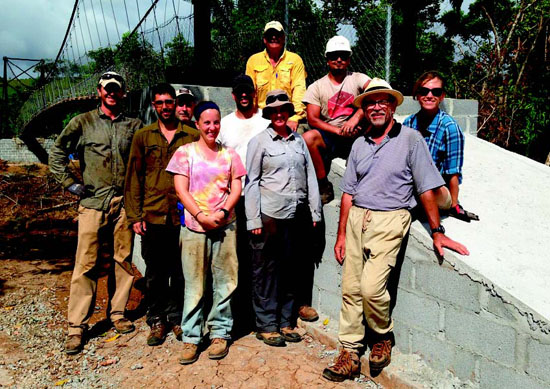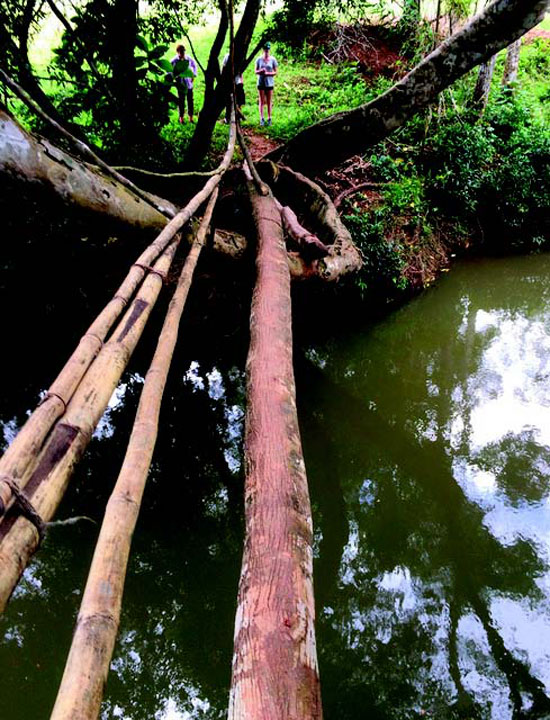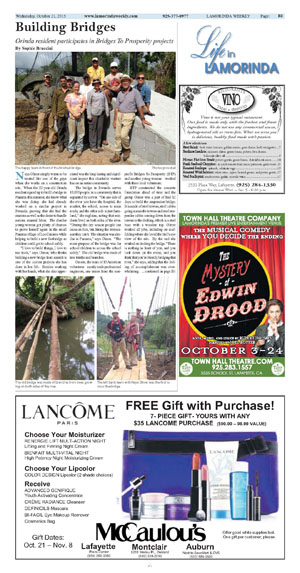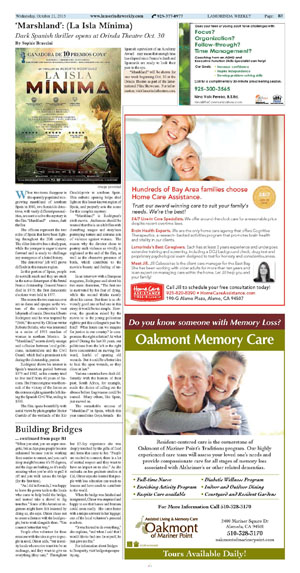|
|
Published October 21st, 2015
|
Building Bridges
|
| Orinda resident participates in Bridges To Prosperity projects |
| By Sophie Braccini |
 |
| The happy team in front of the finished bridge Photos provided |
Naya Olmer simply wants to be treated like one of the guys when she works on a construction site. When the 22-year-old Orinda resident signed up to build a bridge in Panama this summer, she knew what she was doing: she had already worked on a similar project in Rwanda, proving that she had the stamina as well as the desire to handle serious manual labor. The slender young woman got plenty of chances to prove herself again in the small Panama village of Los Canones while helping to build a new footbridge so children could get to school safely.
 "I love to build things, I love to use tools," says Olmer, who thinks building a new bridge from scratch is one of the coolest projects she has done in her life. Besides working with her hands, what she also appreciated was the long-lasting and significant impact this charitable venture has on an entire community.
"I love to build things, I love to use tools," says Olmer, who thinks building a new bridge from scratch is one of the coolest projects she has done in her life. Besides working with her hands, what she also appreciated was the long-lasting and significant impact this charitable venture has on an entire community.
 The bridge in Rwanda serves 10,000 people, in a community that is separated by a river. "On one side of the river you have the hospital, the market, the school, access to main roads, and the other side is just farmland," she explains, noting that residents lived on both sides of the river. "During the dry season people can cross on foot, but during the wet season they can't. The situation was similar in Panama," says Olmer. "The main purpose of the bridge was for school children to access the school safely." The old bridge was made of tree trunks and branches.
The bridge in Rwanda serves 10,000 people, in a community that is separated by a river. "On one side of the river you have the hospital, the market, the school, access to main roads, and the other side is just farmland," she explains, noting that residents lived on both sides of the river. "During the dry season people can cross on foot, but during the wet season they can't. The situation was similar in Panama," says Olmer. "The main purpose of the bridge was for school children to access the school safely." The old bridge was made of tree trunks and branches.
 On site, the team of 10 American volunteers - mostly male professional engineers, one intern from the nonprofit Bridges To Prosperity (BTP) and another young woman - worked with three local volunteers.
On site, the team of 10 American volunteers - mostly male professional engineers, one intern from the nonprofit Bridges To Prosperity (BTP) and another young woman - worked with three local volunteers.
 BTP constructed the concrete foundation ahead of time and the group Olmer was a part of had 12 days to build the suspension bridge. It is made of steel towers, steel cables going across the towers and steel suspender cables coming down from the towers to the decking, which is a steel base with a wooden top. Olmer worked all jobs, including on scaffolding where she loved the bird's-eye view of the site. By the end she worked on decking the bridge. "There is nothing in front of you, and you look down (at the river), and you think that you're literally bridging that river," she says, adding that the feeling of accomplishment was overwhelming. "When you start, you are super energetic, but as days pass people become exhausted because you're working from sunrise to sunset, and you can't sleep at night because it's 95 degrees, and the dogs are barking, so it's really amazing when you're able to pull it off and you walk across the bridge (for the first time).
BTP constructed the concrete foundation ahead of time and the group Olmer was a part of had 12 days to build the suspension bridge. It is made of steel towers, steel cables going across the towers and steel suspender cables coming down from the towers to the decking, which is a steel base with a wooden top. Olmer worked all jobs, including on scaffolding where she loved the bird's-eye view of the site. By the end she worked on decking the bridge. "There is nothing in front of you, and you look down (at the river), and you think that you're literally bridging that river," she says, adding that the feeling of accomplishment was overwhelming. "When you start, you are super energetic, but as days pass people become exhausted because you're working from sunrise to sunset, and you can't sleep at night because it's 95 degrees, and the dogs are barking, so it's really amazing when you're able to pull it off and you walk across the bridge (for the first time).
 "As I did in Rwanda, I was happy to leave the power tools to the locals who came to help build the bridge, and instead take a shovel to dig trenches." Some of the American engineers might have felt lessened by doing so, she says. Olmer chose not to create a distance with the local people, but to work alongside them. "You connect better that way."
"As I did in Rwanda, I was happy to leave the power tools to the locals who came to help build the bridge, and instead take a shovel to dig trenches." Some of the American engineers might have felt lessened by doing so, she says. Olmer chose not to create a distance with the local people, but to work alongside them. "You connect better that way."
 People often volunteer for these missions with the idea to give to people in need, Olmer adds, "but in reality locals who receive want it to be an exchange, and they want to give us everything (they can)." Throughout her 12-day experience she was deeply touched by the gifts of food and items that came to her. "People are excited to connect; there is a lot of mutual respect and they want to have an impact on us also." As she embarks on her graduate studies at Cal, Olmer says she learned that people with less education can teach us lessons and have much to contribute to the world.
People often volunteer for these missions with the idea to give to people in need, Olmer adds, "but in reality locals who receive want it to be an exchange, and they want to give us everything (they can)." Throughout her 12-day experience she was deeply touched by the gifts of food and items that came to her. "People are excited to connect; there is a lot of mutual respect and they want to have an impact on us also." As she embarks on her graduate studies at Cal, Olmer says she learned that people with less education can teach us lessons and have much to contribute to the world.
 When the bridge was finished and inaugurated, Olmer was surprised and happy to see that horses and humans could cross easily. She came home with a unique souvenir in her luggage: one of the local volunteer's personal machete.
When the bridge was finished and inaugurated, Olmer was surprised and happy to see that horses and humans could cross easily. She came home with a unique souvenir in her luggage: one of the local volunteer's personal machete.
 "It was his tool to do everything," she explains, "and when I said that I would like to find one for myself, he just gave me his."
"It was his tool to do everything," she explains, "and when I said that I would like to find one for myself, he just gave me his."
 For information about Bridges to Prosperity, visit www.bridgestoprosperity.org.
For information about Bridges to Prosperity, visit www.bridgestoprosperity.org.

|
 |
| The old bridge was made of branches from trees growing on both sides of the river. |
| |
| |
|
|
|
|
| |
|
|
|
|





